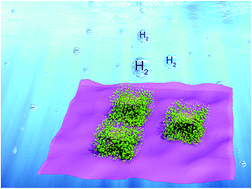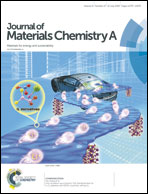Metal–semiconductor ternary hybrids for efficient visible-light photocatalytic hydrogen evolution†
Abstract
Solar-driven production of chemical fuels through photocatalysis holds great promise for addressing the ever-increasing energy and environmental issues. However, its practical application is limited due to low light harvesting efficiency, fast charge recombination, and low stability of current photocatalysts. Here, we introduce a high-performance solar energy conversion platform constructed by the intimate coupling of two different complementary semiconductors (MoS2 and CdS) and morphology-controlled plasmonic metal nanocrystals (concave cubic Au nanocrystals) in a controlled manner. The sequential Au nanocrystal anchoring and CdS growth on two-dimensional exfoliated MoS2 nanosheets successfully yielded intimately coupled plasmonic metal–semiconductor ternary hybrids. The prepared hybrid photocatalysts exhibited superb hydrogen evolution capability under visible-light irradiation, which can be attributed to the synergistic integration of the advantages of semiconductor–semiconductor coupling, such as the broadening of light absorption and the retardation of charge recombination, and plasmon energy transfer from Au nanocrystals to semiconductors via the hot electron transfer mechanism.



 Please wait while we load your content...
Please wait while we load your content...